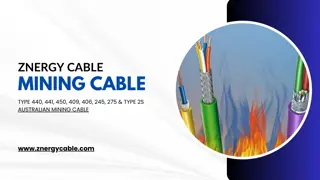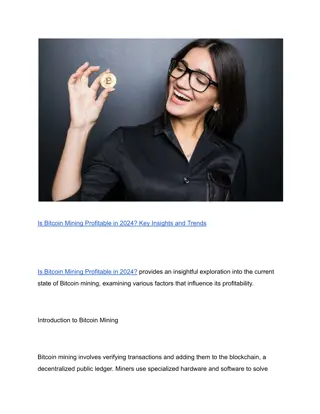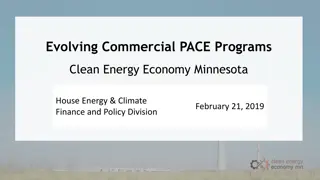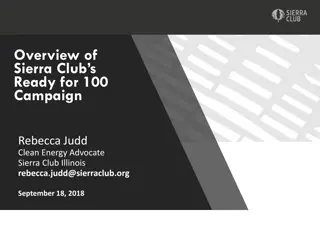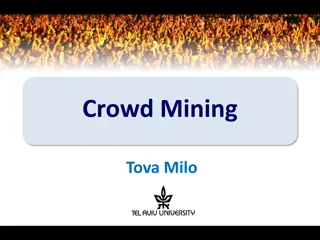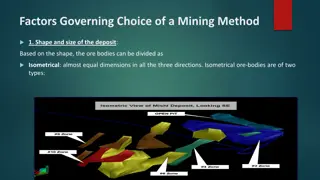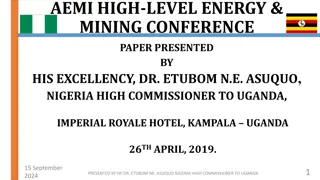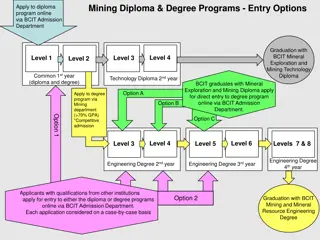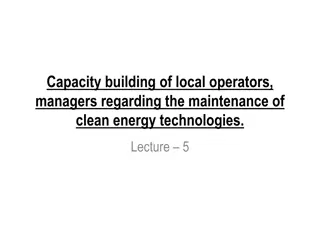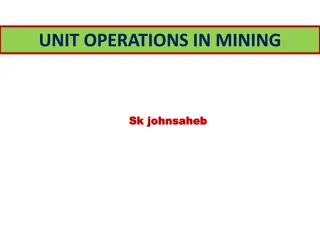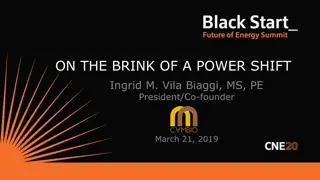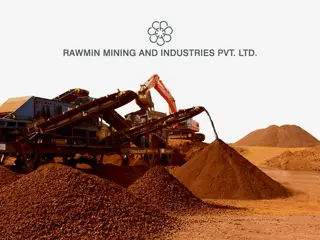Clean Energy Transition, Scarcity and Urban Mining
Explore strategies to sustain the clean energy transition amidst limited resources. Model a producer's decisions and regulatory alignment in maximizing clean energy generation with profitability considerations. Utilize benchmarks for material efficiency, urban mining, and systemic leakage to address scarcity challenges.
Download Presentation

Please find below an Image/Link to download the presentation.
The content on the website is provided AS IS for your information and personal use only. It may not be sold, licensed, or shared on other websites without obtaining consent from the author.If you encounter any issues during the download, it is possible that the publisher has removed the file from their server.
You are allowed to download the files provided on this website for personal or commercial use, subject to the condition that they are used lawfully. All files are the property of their respective owners.
The content on the website is provided AS IS for your information and personal use only. It may not be sold, licensed, or shared on other websites without obtaining consent from the author.
E N D
Presentation Transcript
Clean Energy Transition, Scarcity and Urban Mining presented by Clara Carrera INSEAD, Technology and Operations Management with Serasu Duran1, Atalay Atasu2 and Luk N. Van Wassenhove2 1University of Calgary, Haskayne School of Business 2INSEAD, Technology and Operations Management
Upon the clean energy transition limited & concentrated supply may not catch up with demand Copper Lithium Cobalt Energy installations, GW Expected demand vs supply 2020 Mine production 2030 2020 2030 2020 2030 Net Zero Scenario demand 20212030 20212030 2021 2030 28% 52% 70% Supply concentration (Extraction & Processing) Today Net Zero Scenario Paris Agreement 40% 58% 65%
How can we maintain the clean energy transition in the face of scarcity? No investment Investment Benchmark Material Reduction Urban Mining Secondary Supply Systemic Leakage Waste Waste Waste Energy efficiency
We model a monopolist producer and check alignment with regulator objectives Maximize clean energy generation Maximize expected profits Maintain industry production and profitability Profit = Revenues - Costs Decisions: Virgin Material purchases Investment decisions (Y/N + quantity) Decisions aligned? Where to intervene?
Our model Producer contracts q units Market baseline revealed Producer pays price Scarcity Price increases with consumption Material Costs Volatility Random component Time 1 unit of critical material 1 clean tech product 1 MWh of clean energy Benchmark Material efficiency Energy conversion Material Reduction Revenues Urban Mining
Results Material reduction Urban mining Maximize clean energy generation Material Reduction Benchmark Urban mining Benchmark But! Systemic leakage Recycled % Virgin material consumption Jevons paradox (1865) Scarcity level Maintain industry production and profitability Material Reduction Urban mining Benchmark
What should policymakers do? Producer strategy by scarcity and systemic leakage UM misalignment Material Reduction Alignment Material Reduction MR misalignment Benchmark Systemic leakage Subsidize Urban Mining/ Material Reduction costs? Improve access to EOL products? Urban Mining Scarcity level UM Preferred by Policymaker MR Preferred by Policymaker
Concluding remarks Clara Carrera clara.carrera@insead.edu
What about opening new mines? Opening a new mine can take up to 15 years. Successful outcomes not guaranteed. Opposition and protests.
Extension 1: Independent Recycler Industry practice: Vertically integrated set-up Ford: recycling facility in Tennessee, Renault: Refactory, 2024. Examples: Third-party recyclers that do not manufacture SolarCycle, US Decoupling: Benefits of urban mining hold, less strong due to double marginalization. Recycler sells material to commodity market, the critical material can be lost to other industries.
Extension 2: What if we do BOTH Material Reduction and Urban Mining? Two opposing effects: Positive: Recover materials and build even more due to lower material content -> Increased revenues. Negative: Increase urban mining cost (reduced material density), need more collection and processing In most cases, the strategies are substitutes, not complements
Benchmark model Supply Installed base Revenues qB units of material = qBproducts = qBMWh Cost of purchasing qB units Waste
Material reduction model Supply Installed base Waste Additional processing costs Cost of purchasing qM units 1 unit of material -> 1+ ? products X Efficiency loss: 1+ ? products -> 1 + (1 ?)? MWh Trade- off Revenues ??units of material = (1 + ?)??products = (1 + (1 ?)?)??MWh X Additional cost c X Convex R&D costs
Urban Mining model Virgin Supply Installed base Secondary Supply Leakage Waste Marginal recycling costs Cost of purchasing qU units Recover r units of material Fixed recycling costs X Initial investment cost Trade- off Revenues: X Convex recycling costs cRr2 ??+ ? units of material = ??+ ? products = ??+ ? MWh X Limited by EOL products: ? (1 )(qU+ r)
Material reduction results (1/2) If ?, and ? are below a certain threshold No installations when ? ? ? Otherwise Reduction proportional to (1 ?)? ?
Urban Mining results (1/2) - Interior solution, when ? < ?? ? and ? < ?( ,?) - Boundary solution, when ?? ? < ? < ?? ? and ? < ?( ,?) - Benchmark solution, otherwise
The path to the renewable energy transition Low scarcity High scarcity Prob of negative profits and production range Prob of negative profits and production range Clean energy generation Clean energy generation Profits Profits Benchmark Material Reduction Depends on and Depends on and Urban mining



